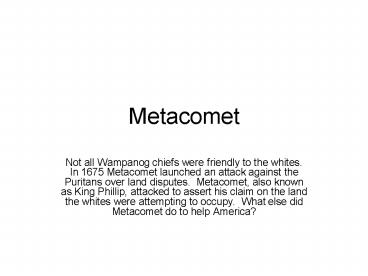Metacomet - PowerPoint PPT Presentation
1 / 11
Title:
Metacomet
Description:
In 1675 Metacomet launched an attack against the Puritans over land disputes. ... For instance, beavers, large bears, cougars, panthers, and other animals once ... – PowerPoint PPT presentation
Number of Views:70
Avg rating:3.0/5.0
Title: Metacomet
1
Metacomet
- Not all Wampanog chiefs were friendly to the
whites. In 1675 Metacomet launched an attack
against the Puritans over land disputes.
Metacomet, also known as King Phillip, attacked
to assert his claim on the land the whites were
attempting to occupy. What else did Metacomet do
to help America?
2
(No Transcript)
3
Metacomet was a Wampanoag chief in the mid 1600s.
In 1675 he launched an attack on the Puritans of
Massachusetts Bay Colony over land claims. The
size of the Massachusetts Bay colony grew in the
1640s and 1650s. To accommodate the growing
population, the colonists moved further west into
Wampanoag territory to find resources. Because
the Europeans were moving onto their land,
depleting resources, and forcing the Wampanoags
further inland, Matcomet, also known as King
Philip, and his fellow warriors attacked to
defend their traditional homeland and assert
their rights. This drawing shows an artists take
on a meeting between Metacomet and the colonists.
Wood, S. N. (c. 1911). King (Metacomet)
Philip, Sachem of the Wamponoags, d. 1676, full
length, standing at treaty table with whie men.
Library of Congress Prints Photographs.
4
(No Transcript)
5
Native Americans and Europeans had different
beliefs about how land should be used. The Native
Americans believed that people had a special
relationship with the land and did not own it,
but instead simply used it responsibly. In
contrast, the Europeans believed land was meant
to be used, exploited, and owned by people. So,
when the Europeans saw how Native Americans used
the land, they believed that they could take it
because the Native Americans did not own it.
Vinckeboons, J. (1639). Pascaert van Nieuw
Nederlandt Virginia, ende Nieuw-Engelandt
verthonendt alles wat van die landin by See, oft
by land is ondect oft Bekent. Library of
Congress American Memory, Map Collections
1500-2004.
6
(No Transcript)
7
By owning the land and introducing new farming
techniques, the Europeans changed the layout of
the land and its ecosystems. For instance,
beavers, large bears, cougars, panthers, and
other animals once thrived in New England . But a
combination of ecosystem change and hunting (for
skins like those seen here) severely decreased
the population of these animals and sometimes led
to outright extinction. Keystone View Company.
(c1899). Laliberte's fur parlor--the finest in
the world, Quebec, Canada. Library of
Congress Prints Photographs, Sterograph Cards.
8
(No Transcript)
9
This painting, created in the mid 1800s, shows
what an artist imagined Plymouth , Massachusetts
to look like in 1620. The artist depicts a rocky,
hilly terrain complete with large trees and
vegetation. According to the studies of
environmental historians like William Cronon,
this was not far from the truth. Massachusetts in
the 17 th century was a densely forested region.
N. Currier. (1838-1856). Landing of the
pilgrims at Plymouth 11th Dec. 1620. Library of
Congress Prints Photographs, Popular Graphic
Arts.
10
(No Transcript)
11
This is a picture of Massachusetts in the 1900s.
Years of invasive farming techniques changed the
physical layout of the land. Much of what was
once dense forest became, over time, a flatter
land that was more suitable to the agricultural
needs of the areas inhabitants. Dick, S.
(1938). New England hurricane. Onion field near
Hadley, Massachusetts. Library of
Congress Prints Photographs.































